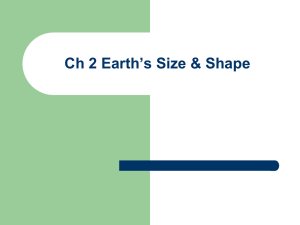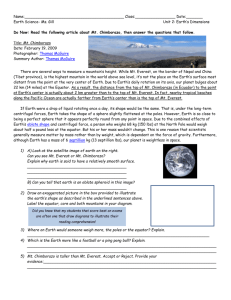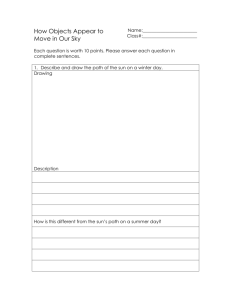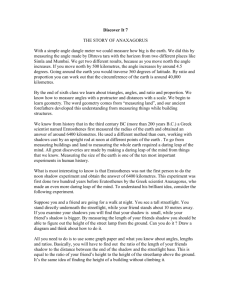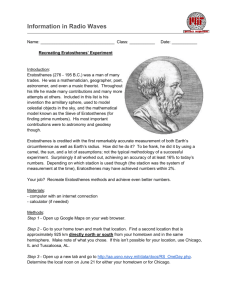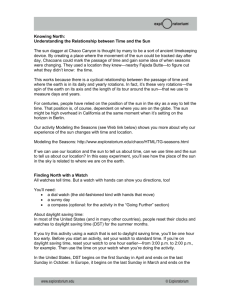Eratosthenes' Determination of Earth's Circumference
advertisement
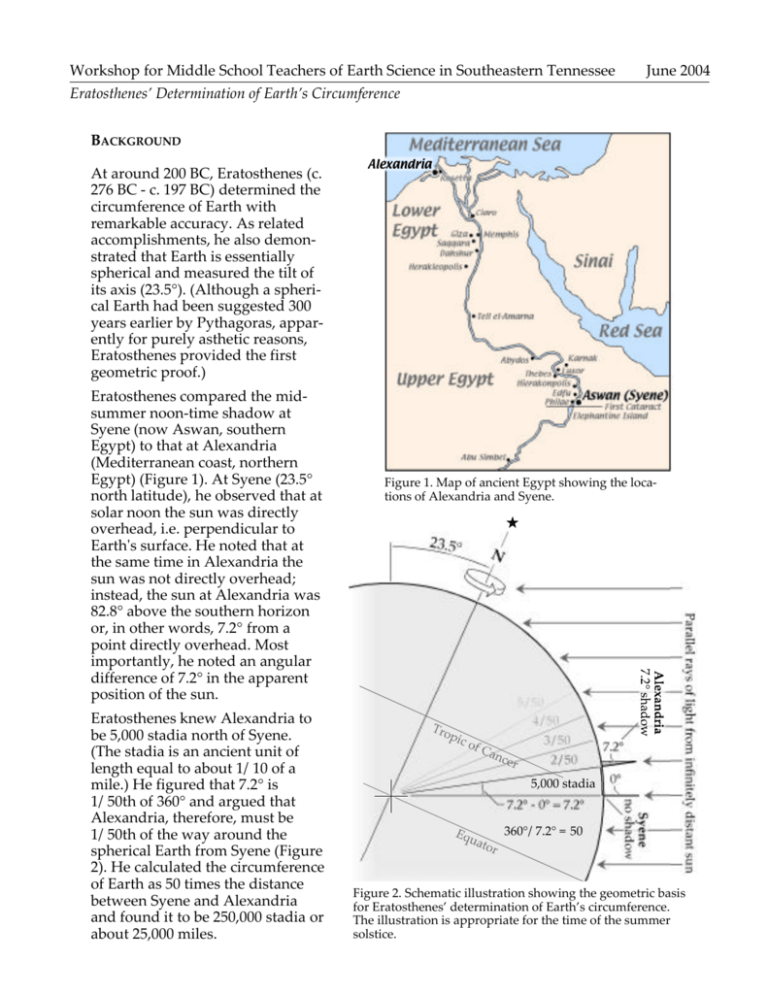
Workshop for Middle School Teachers of Earth Science in Southeastern Tennessee June 2004 Eratosthenes’ Determination of Earth’s Circumference BACKGROUND At around 200 BC, Eratosthenes (c. 276 BC - c. 197 BC) determined the circumference of Earth with remarkable accuracy. As related accomplishments, he also demonstrated that Earth is essentially spherical and measured the tilt of its axis (23.5°). (Although a spherical Earth had been suggested 300 years earlier by Pythagoras, apparently for purely asthetic reasons, Eratosthenes provided the first geometric proof.) Eratosthenes compared the midsummer noon-time shadow at Syene (now Aswan, southern Egypt) to that at Alexandria (Mediterranean coast, northern Egypt) (Figure 1). At Syene (23.5° north latitude), he observed that at solar noon the sun was directly overhead, i.e. perpendicular to Earth's surface. He noted that at the same time in Alexandria the sun was not directly overhead; instead, the sun at Alexandria was 82.8° above the southern horizon or, in other words, 7.2° from a point directly overhead. Most importantly, he noted an angular difference of 7.2° in the apparent position of the sun. Eratosthenes knew Alexandria to be 5,000 stadia north of Syene. (The stadia is an ancient unit of length equal to about 1/10 of a mile.) He figured that 7.2° is 1/50th of 360° and argued that Alexandria, therefore, must be 1/50th of the way around the spherical Earth from Syene (Figure 2). He calculated the circumference of Earth as 50 times the distance between Syene and Alexandria and found it to be 250,000 stadia or about 25,000 miles. Alexandria Figure 1. Map of ancient Egypt showing the locations of Alexandria and Syene. 5,000 stadia 360°/7.2° = 50 Figure 2. Schematic illustration showing the geometric basis for Eratosthenes’ determination of Earth’s circumference. The illustration is appropriate for the time of the summer solstice. DETERMINING EARTH’S CIRCUMFERENCE BY ERATOSTHENES METHOD Eratosthenes’ method requires that one know or determine the vertical angle of the sun above the horizon or from the zenith (a point directly overhead) at solar noon at two locations along the same line of longitude. The distance between the two locations must also be known. Solar noon is the time at which the sun reaches its highest point in the sky and is closest to being directly overhead. This is the time at which the sun passes directly over the observer’s line of longitude and is known as the time of the sun’s transit. It is commonly NOT the same as 12:00 noon by civil time. The precise time (civil time) of solar noon at a particular location can be found using computer software and is provided by numerous web sites. Alternatively, the time of solar noon can be figured as the mid point between times of sunrise and sunset, which are commonly available in local newspapers. Determining the Sun’s vertical angle is most easily accomplished by measuring the shadow cast by a vertical pole of known length (L) onto a horizontal plane. In this case, the pole and its shadow (l) are two sides of a right triangle. The interior angle of this triangle opposite the shadow is equivalent to the angle of the sun from the zenith (Figure 2). Students may benefit from having to work out the details of how to measure the angle of the sun using a pole and its shadow. However it might be accomplished, the pole must be vertical and the flat surface, upon which the pole’s shadow is cast, must be horizontal. Further, there should be a convenient way of measuring and recording the length of the shadow and that of the pole. The possibilities include: To zenith (straight up) Ray of light from sun Protractor L Vertical pole of length (L) l Shadow l Horizontal plane Figure 2. Schematic illustration showing how a shadow cast from a vertical pole onto a horizontal plane relates to the angle of the sun from the zenith. 1. Use gravity to ensure that the pole is vertical. Hang the pole from one end using thread or fishing line such that it acts like a plumb bob. 2. If the hand is too unsteady, hang the pole under a tripod or other supporting structure. 3. Cast the pole’s shadow onto a small dry-erase board and trace its length using a dryerase marker. 4. Cast the pole’s shadow onto a sheet of paper with graduated concentric rings. Configure the shadow such that one end is at the center of the rings. Use the rings to measure its length or calibrate the rings such that the sun’s angle is read directly from them. 5. Use a carpenter’s level or a bulls-eye level to level the shadow surface. 6. Use a jar of colored water marked with a level line to level the shadow surface. (This is more inventive than #5.) 7. Support the shadow surface with rocks, sand, or wedges to adjust its angle (horizontal). 8. Make numerous observations through the mid-day period to find the time at which the pole’s shadow is shortest; this is solar noon. A possible configuration is shown in Figure 3. Figure 3. A possible configuration of equipment to measure the angle of the sun in the sky. As yet another possibility, measure the shadow cast by a flag pole or utility pole. Of course, the height of the pole must also be determined or known and the surface upon which the shadow is cast, the ground, must be horizontal. This would take advantage of an existing structure, just as Eratosthenes did when he noted the absence of a shadow at the bottom of a vertical well in Syene. Jar with water AN EXAMPLE Fort Wayne, Indiana, is 666 km (414 miles) due north of Chattanooga, Tennessee. (Note that this is straight-line or great-circle distance, not highway distance.) Both cities are at 85.2° west longitude. On January 10, 2004, both cities experienced solar noon at 12:48 pm. Your observations in Chattanooga at solar noon on this day would have indicated that the sun was 33.0° above the horizon or 57.0° from a point directly overhead. In Fort Wayne, Indiana, it would have been observed that the sun was 27.0° above the horizon or 63.0° from a point directly overhead. The difference in the angles of the sun at the two locations is 6°. Fort Wayne is, therefore, 6° north of Chattanooga (Figure 4). Six degrees is 1/60 of 360°. Therefore, 666 km (414 miles) must also be 1/60 of Earth’s circumference. Tripod String or fishing line Ray of light from sun Vertical pole of length (L) serves as a level Shadow l Graduated rings Horizontal plane Small rocks for adjustment Fort Wayne 63° shadow Chattanooga 57° shadow 63° - 57° = 6° In kilometers, Earth’s circumference is given by 666 km x 60 = 39,960 km . In miles, Earth’s circumference is given by 414 mi x 60 = 24,840 mi . Figure 4. Schematic illustration showing the geometric basis for applying Eratosthenes’ method to the example of Chattanooga and Fort Wayne on January 10, 2004. Compare this to Figure 2; note the difference in the tilt of Earth’s axis. HOW THIS ACTIVITY MIGHT BE IMPLEMENTED Eratosthenes’ method of determining Earth’s circumference could be implemented as an activity in any number of ways. For example, students at two widely separated schools along the same line of longitude (e.g. Chattanooga and Fort Wayne) could measure the angle of sun, as described here, and could share their information with each other to make their calculations. He internet facilitates this approach. Alternatively, students at one school could measure the angle of the sun, as described here, and make calculations based on information for another location gathered from the internet. Computed values for day length, sunrise, sunset, solar noon and altitude, etc. can found at the following web sites: http://www.umzugs.com/time/time.html http://aa.usno.navy.mil/data/docs/RS_OneDay.html http://www.sci.fi/~benefon/sol.html http://www.ga.gov.au/nmd/geodesy/astro/sunrise.jsp As a variant of this approach, the teacher could gather information for the second location from the web and provide it to students in the context of a fictitious scenario. Distances between the two locations can be determined from a map or a globe. Alternatively, on-line calculators for straight-line or great-circle distances can be found at the following web sites: http://www.wcrl.ars.usda.gov/cec/java/lat-long.htm http://people.hofstra.edu/geotrans/eng/ch1en/conc1en/greatcirclecalc.html http://www.wfu.edu/albatross/gcircle/calcfull.html http://www.geocities.com/CapeCanaveral/2265/gcsail.htm
